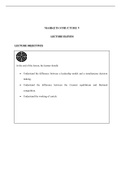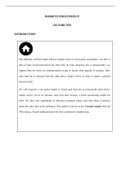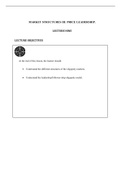ECONOMICS : MICRO ECONOMICS THEORY III
Columbia University
All 3 results
Sort by

-
MARKETS STRUCTURE V : MICRO-ECONOMICS THEORY III
- Class notes • 14 pages • 2021
-
Ben002
-
- $13.49
- + learn more
In a Bertrand model, each firm chooses its price given its believes about the price that the other firm will choose and the only equilibrium price is the competitive equilibrium. a cartel consists of a number of firms colluding to restrict output and maximize industry profit. A cartel will typically be unstable in the sense that each firm will be tempted to sell more than it’s agreed upon output, if it believes that the other firms will not respond

-
MARKETS STRUCTURES IV : MICRO-ECONOMICS THEORY III
- Class notes • 12 pages • 2021
-
Ben002
-
- $14.49
- + learn more
In a Cournot model each firm chooses its output so as maximize its profits given its believes about the other firms choice and equilibrium is realized when each firm finds its expectations about the other firm’s choice to be confirmed

-
MARKET STRUCTURES III: PRICE LEADERSHIP. (MICRO-ECONOMICS THEORY III)
- Class notes • 10 pages • 2021
-
Ben002
-
- $14.29
- + learn more
An oligopoly is characterized by a market with a few firms that recognize the strategic interdependence. There are several possible ways for oligopolies to behave depending on the exact nature of their interaction. In a price leader model, one firm sets its price and the other chooses how much it wants to supply at that price. The leader has to take into account the reaction of the follower. COMPARING PRICE LEADERSHIP AND QUANTITY LEADERSHIP. We have seen how to calculate the equi...

How much did you already spend on Stuvia? Imagine there are plenty more of you out there paying for study notes, but this time YOU are the seller. Ka-ching! Discover all about earning on Stuvia


